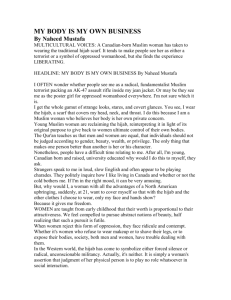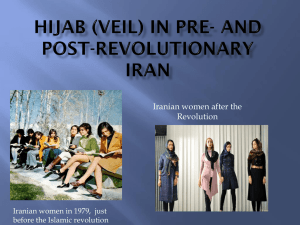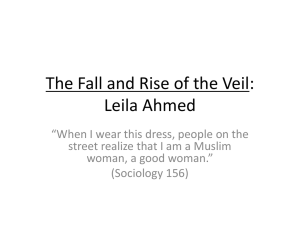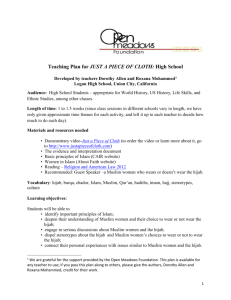Intersections of Cross-Cultural Style: Integrating Functional Design into the Socio-Religious Hijab Headscarf
advertisement
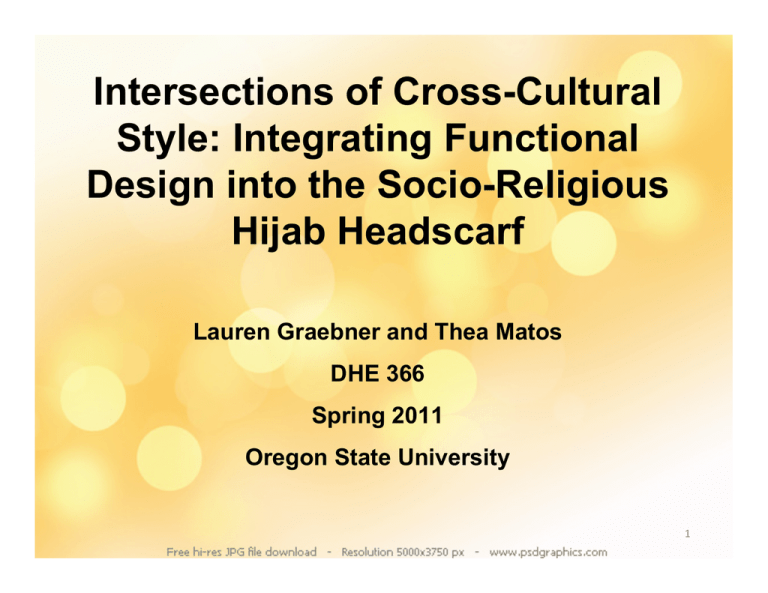
Intersections of Cross-Cultural Style: Integrating Functional Design into the Socio-Religious Hijab Headscarf Lauren Graebner and Thea Matos DHE 366 Spring 2011 Oregon State University 1 DHE 366: GROUP RESEARCH PROJECT Cross-Cultural Aspects of the Near Environment Prompt Provided by Instructor: The term project for this course will be a group research project for which you will create a cross-cultural near environment object/product and present your research findings and creation to the class. You will choose a scenario that highlights a process of cultural change – for example, design an ensemble for an individual that is a member of the culture you researched. Suppose that this individual is moving to the United States to study abroad at Oregon State University. Incorporate elements of his or her own culture to help him/her feel comfortable, while helping him/her to acculturate to the United States culture. The project will help your group to learn about culture and its influence on the near environment through applied comparison and design. The purpose of the project is to present as complete an explanation of your culture as possible that provides support for your creative element(s). 2 Premise of DHE 366 Group Research Project: This project is based upon the concepts presented in course readings for Weeks 2 and 3, related to the processes of cultural change (acculturation and cultural authentication). In particular, it is related to the following required reading for Week 2: Lin, R. T. (2007). Transforming Taiwan aboriginal cultural features into modern product design: A case study of a cross-cultural product design model. International Journal of Design, 1(2), 45-53. **Specifically, this reading states the following on page 45: “Relevance to Design Practice - The cross-cultural product design model proposed and discussed in this paper is of value for designers because it can help to design ‘culture’ into modern products, as well as provide designers with a valuable reference for designing a successful cross-cultural product.” Products with cultural features enhance product value and have more global market value. A “Cultural Layers of Cultural Design” Table will be distributed later in the term to aid understanding of this process. The purpose of using these layers and levels is to transfer cultural features to design elements which in turn are used to develop near environment designs. Each designer contributes knowledge of their personal culture to the design process. To achieve successful cross-cultural design, you ideally need to achieve all three layers of design. Therefore, it is not enough to achieve the visceral level of design (the lowest level). 3 Premise of DHE 366 Group Research Project, Continued: This project was based upon concepts presented in course readings related to the processes of cultural change (e.g., acculturation and cultural authentication). In particular, the project asked students to consider the cross-cultural design process presented by Lin (2007) in her scholarly article titled, “Transforming Taiwan aboriginal cultural features into modern product design: A case study of a cross-cultural product design model.” The argument presented by Lin is that products with cultural features enhance product value and have more global market value and, thus, one ideally needs to achieve all three proposed layers of design to achieve successful cross-cultural design. 4 Our Cross-Cultural Design Scenario and Process • Our research was devoted to an investigation of the acculturation process that a Muslim woman of Palestinian culture and her dress undergo when she becomes part of United States culture as a university student studying abroad. We found that research related to this scenario has been previously conducted by Cole and Ahmadi (2003) and Speck (1997). Research related to the issues that Muslim women face in the acculturation process has also been reported by Ba-Yunus and Kone (2006), Hasan (2000), and Smith (2010). • We aspired to create a culturally modified hijab headscarf by using scholarly sources to inform the development of a design that would maintain a level of cultural sensitivity and meet the functional needs of a cross-cultural client. • The hijab headscarf plays a significant role in Muslim women’s dress, for it’s a symbol of cultural, religious and traditional values (Farsoun, 2004; Haddad & Lummis, 1987; Karim, 2009; McDowall, 1994; Meibar, 1982; Smith, 2010). This project was designed to help us further understand the physical and psychological dress needs of hijab-wearing Muslim women in a cross-cultural setting. 5 What is hijab? What is the hijab headscarf? The hijab is a garment that holds great significance in the socio-religious culture of Muslim traditional dress (Beall, 2008; Tarlo, 2010). Islam is the religious practice of following the prophet Mohammad and those practicing Islam call themselves Muslim (Farsoun, 2004; Haddad & Lummis, 1987). Hijab is a term often used to refer to “Islamic clothing, which includes covering the hair, neck, bosom, and womanly curves” (Mullet & Park, 2011a, p. 226). Hijab can take the form of a headscarf that is used to primarily cover the hair and neck. One of the ideological principles surrounding Islam is modesty (Beall, 2008; Parker, 1996). In Islamic socio-religious culture, hair is thought to be a very seductive part of the women’s body, so the hijab is used as an expression of sexual modesty and explicit recognition of the woman’s place in society. “I believe in hijab and I believe it is to protect us” (N. Alshare, personal communication, May 20, 2011). In recent years the practice of hijab has been represented on fashion runways; these designs allow women to embrace fashion and adhere to their chosen socio-religious path. 8 3 4 3 6 Our Cross-Cultural Design/Creative Element 7 Photos of “LT hijab headscarf”, courtesy of Taylor Hunt 8 Our Design: We have designed a head adornment piece (referred to as “LT hijab”) that would meet the needs of cultural adjustment for a Muslim female in the United States. It was important that the LT hijab served the same purpose of modesty, which provides multiple levels of protection for Muslim women. Parker (1996) states that the sense of modesty derived from hijab is important because “hijab protects woman from the male gaze” (“The Ongoing Debate” section). The LT hijab includes a two-piece set comprised of a knit headband and tube (or infinity) scarf that, when combined, serve the function of hijab. The headband in our design functions by securing and covering the hair around the face. Around the neck and chest a scarf is worn which can be pulled up over the head and attached to the headband with a button. This ensures that the hair will be covered at all times, unless purposefully removed. Button Headband Tube (or infinity) scarf 9 Design Explanation and Justification: We chose to make a two-piece hijab headscarf set with the intention that it could be worn as a hijab or separately, as a headband and scarf. Designed in this manner, it can help women acculturate into the United States culture because it is similar to what a non-Muslim Western woman would likely wear. We chose to use a knit fabric because of the drape and stretch. The stretch allows the hijab headband to stay in place and pull hair back from the face. The drape keeps the scarf near the face and allows it to frame the face in an aesthetically-pleasing manner. We chose the colors red and purple. (The focus group participants, discussed later in this presentation, felt that red and purple were culturally appropriate in the United States and wouldn’t draw too much attention to them.) We placed a button on the top of the scarf that can attach it to the headband to make sure that it stays securely in place. The button is an important feature because women who wear the hijab headscarf on a regular basis “often have to re-wrap [their] traditional hijab throughout the day” (N. Alshare, personal communication, May 20, 2011). We wanted our hijab headscarf to stay in place throughout the day and keep its wearers feeling protected and modest. The two hijab headscarf prototypes that we designed come in two weights of fabric: heavier for colder months and thin for summer months. Because the hijab is worn year round by Muslim women, we wanted ours to accommodate the changing seasons. (Focus group participants also indicated that this was a desired feature [E. Maqsood, personal communication, May 20, 2011]). 10 Cross-Cultural Design Inspiration 11 2 Our initial inspiration came from two up-and-coming trends that have recently been seen in the Western media and miscellaneous fashion trend coverage. We browsed and reviewed the content of fashion magazines, including Vogue and Harper’s Bazaar (to name a few) for inspiration. This search for inspiration provoked many ideas and led us to consider fashion products being sold by certain retailers, such as J. Crew (see picture above). The first trend is a headband (pictured on this slide) that is wide enough to cover most of a woman’s hair in the front. We believed that this would serve the purpose for a transition stage in adaptive acculturation to Western culture and dress. 12 In addition to the headband would be the second trend, a tube scarf or infinity scarf, which is also a desirable product on the market in the United Sates. “The infinity or circular scarf is much like a traditional scarf, but with no end. A circular scarf that can be looped around the neck once, twice or multiple times” (“The Infinity Scarf,” 2010). We chose this inspiration because the scarf is worn around the neck and can also be pulled up over the head covering all visible parts of the hair and neck (Turner, 2010). The headband can be used as a supplemental piece to ensure full coverage of desired areas on the body. 1 7 13 5 4 Why create an alternative option to the traditional hijab headscarf? Some women feel uncomfortable in the United States wearing the hijab, for they often get mocked and discriminated against for doing so. There are many misunderstandings and stereotypes associated with hijab and hijab headscarves that can prevent or delay adaption in the process of acculturation (Ba-Yanus & Kone, 2010; Cole & Ahmadi, 2003; Hasan, 2000; Speck, 1997). Our design is very versatile and can be worn in a variety of configurations, sending a different message to the viewer when desired. Also, the variety of possible configurations allows flexibility for a woman as she establishes her identity in a cross-cultural context. This can increase both her physical and psychological comfort. 14 Design Critique Via Focus Group and Scholarly Research 15 We decided to hold a focus group with a few women from the Saudi Arabian Students Association (SASA) at Oregon State University to provide us with a better understanding of hijab and its religious and cultural significance, as well their feedback on our hijab headscarf design. We wanted our hijab headscarf to maintain cultural sensitivity, and we knew that a focus group would help us do so. We contacted the women by emailing the President of SASA, asking for female participants that wear the hijab headscarf on a regular basis to meet with us and answer a series of questions. The President forwarded our email to the SASA listserv and four women from the club contacted us, stating that they were interested. The women were all undergraduate and graduate students at Oregon State University with majors ranging from chemical engineering to apparel design. They had been in the United States for between 2-5 years. *Hely and Maha are wearing the LT hijab headscarf Photo by Taylor Hunt 16 During our meeting we asked the participants many questions to assist in the critique of our design, such as: -Is there significance in the way you wrap the traditional hijab headscarf? -Why did you choose to wear the hijab headscarf without the face veil and traditional black color? -Is the way you wear the hijab headscarf in the United States different from the way you wore it in your culture of origin (for most participants, this meant Saudi Arabia)? -Would it be culturally insensitive for a non-Muslim woman to wear the same headband and scarf as you in a different and less modest way? -What do you think of our hijab headscarf design? We gained so much information from conducting personal research and are truly thankful to the participants for their insight. Photo by Taylor Hunt 17 Why We Chose to Incorporate a Design Critique with Focus Group Participants: A unique aspect of the research conducted for our project is that it was collected and then practically applied to the design of a culturally sensitive hijab headscarf. That is, the research informed our functional, yet fashionable design. By conducting thorough research beforehand, we ensured that the definition of the design problem addressed the true needs of the end user. The needs of the end user were then confirmed and further defined by focus group participants who critiqued the design prototype. It is common in the clothing and textiles discipline to conduct qualitative interviews or focus groups to determine the clothing needs of a certain market or type of client or draw upon members of a certain market to critique a design informed by the completed research and analysis. 18 Focus Group Findings: When I wear black it is for my culture, when I wear hijab it is for my religion” (E. Maqsood, personal communication, May 20, 2011). In Palestine and Saudi Arabia, women are most often seen wearing a black hijab and boshiya, a veil covering the face from below the eyes (“Traditional Saudi Dress/Clothing,” n.d.). When we met with Elham, she explained that in the United States she chose to wear only the hijab, and the color or appearance didn’t matter as long as her neck, hair, and chest were covered. She continued to explain that the hijab was part of her religion, and the color black and the boshiya were a part of her culture. While studying in the United sates she chose simply to follow her religious beliefs. She believed in the importance of covering her hair and all of the skin on her body except for her face. “If I wore black here and covered my face, I would draw more attention to myself” (E. Maqsood, personal communication, May 20, 2011). Conversely, if she were in Saudi Arabia, she explained that she would draw more attention to herself by not wearing the cultural boshiya garment. 19 Focus Group Findings: “We can be stylish with our clothes and hijab too” (N. Alshare, personal communication, May 20, 2011). “Is it possible to look both fashionable and Islamic? Ask that question to young British Muslim women today and many would almost certainly answer ‘yes’. For some ‘Islamic fashion’ means wearing fashionable clothes ‘Islamically’, but which they mean in conformity with covering restrictions based on interpretations of Islamic texts. For others it means selecting from a new range of clothes designed and marketed specifically as ‘Islamic fashion’” (Tarlo, 2010, p. 189). 6 Muslim women seek fashionable styles (e.g.. Warburton, 2008). Our design offers a new and fashionable option for Muslim women and could be supported in the fashion market. 20 Focus Group Findings: After further research, we found that are design would be especially beneficial to pre-teens in Middle Eastern cultures where the hijab headscarf is worn on a regular basis. Elham mentioned that, in Saudi Arabia, girls tend not to wear the hijab until puberty. They try to slowly get the girls accustomed to wearing the wrapped head adornment by simply wearing the scarf first, and then covering their heads. By wearing our two-piece hijab set, a girl could begin by wearing the headband or the scarf as an individual accessory to get used to the feel of being covered in an area that they are not accustomed to. When a girl is raised in the Middle East it is likely that she is being socialized with the expectation that she will wear the hijab beginning around puberty, along with her peers, symbolizing a right of passage. Girls who move from Palestine to the United States enter a process of acculturation and, therefore, may not be as comfortable with the expectation that they will wear the hijab. “I have a daughter that is about to wear the hijab soon and I am worried about this transition” (E. Maqsood, personal communication, May 20, 2011). If they have the option of wearing a garment that their peers of any cultural background may be wearing as well, they are likely to respond more positively to this change/expectation. 21 Focus Group Findings: Along with our hijab design, we have designed an outfit consisting of garments that could be considered world dress. In countries dominated by Islam today, the majority of women have adapted to world fashion, making their dress acceptable in both the United States and in Islamic cultures (Tarlo, 2010). This phenomenon can be clearly seen in the 2009 film, “Amreeka” (Barkin & Dabis, 2009). Our viewing of this film/documentary provided a visual for how a Palestinian woman might incorporate Western dress in to her traditional Palestinian dress. While they are free to experiment with new trends to appear fashionable, there are still religious norms surrounding modesty (M. Albarjas, personal communication, May 20, 2011). To accommodate these needs, we have chosen an outfit that covers all skin except for the face. In the illustration below we have a woman depicted in jeans and a long sleeve shirt. The outfit is replicated twice, showing two different ways our headband and scarf can be worn to meet diverse cultural and religious needs, as well as situational differences that call for certain garments or styles to be worn (e.g., formal dress versus casual dress). 22 Fashion Illustrations by Lauren Graebner 23 How our Design Achieved the Levels of Cross-Cultural Design in the Product Design Model (Lin, 2007) The purpose of using these layers and levels is to transfer cultural features to design elements which in turn are used to develop near environment designs. Each designer contributes knowledge of their personal culture to the design process. To achieve successful cross-cultural design, you ideally need to achieve all three layers of design. Therefore, it is not enough to achieve the visceral level of design (the lowest level). 24 Product Design Model (Lin, 2007) (Lin, 2007, p. 46) These levels, layers, and design features are described in detail in subsequent slides. Please read on for more detail. 25 The Product Design Model Explained Lin (2007) developed a Product Design Model as a design process used to design cultural products from a cross-cultural perspective. Using the three levels of design features identified by Norman (2005). [There is a direct] relationship between the two ideas; cultural level and design features. The process involves using the three culture levels and identifying those with the three different features of design, including visceral, behavioral and reflective. In order to use these three design features in a product, there are four steps of the cultural design process which are followed: investigation, interaction, development and implementation. First, investigation occurs when defining the standards for the two different traditional cultural wear. Next is the identification or interaction stage, where looking into sources and identifying key elements that define visceral, behavioral and reflective design. Visceral design is at its tangible or physical surface level. The observer can clearly notice that a cultural design feature is applied in different product. Textile patterns and garment shapes are most often used indicate a cultural influence. The use of a Tartan plaid or kimono shaped garment are simple examples of design features that are easily identified to a culture. (Excerpt from Mullet & Park, 2011b, p. 59) 26 The Product Design Model Explained, continued Behavioral design elements refer to their functional usability. When a designer creates something at this level, they are trying to change how the product is used or influence to the consumer to rethink the function. For example, a sneaker with heels would change this sneaker at its functional level; this design does not function as a sneaker anymore, but also does not fit in the category of dress shoes; it needs a category of its own. Reflective design elements are at its intangible level. The meaning of the design is understood by the specific culture, but may not be apparent to others. An example is the use of red in traditional Chinese dress. When a westerner observes this dress, it is just a regular dress that may even hold a color connotation of promiscuity. However, when a Chinese audience is looking at this dress, it is undeniably a traditional color for a wedding dress. The environment and traditions of a culture influence the development of design elements at the reflective level. Using the three levels of culture and developing design elements for each of the three levels, these can be used to develop a more culturally acceptable design or “ideal garment”. (Excerpt from Mullet & Park, 2011b, pp. 59-60) 27 Cultural Level Outer “Tangible” Level Physical/Material Mid “Behavioral” Level Social/Behavior Inner “Intangible” Level Spiritual/Ideal Cultural Layers of Product The LT hijab comes in a variety of fabrics and textures to allow for daily wear through the seasons and for the warm Middle East or the rainy northwest United States. Design Features of Product The LT hijab has similar lines and drape of the traditional hijab. Our hijab comes in a variety of colors which are culturally appropriate in the United States to allow for acculturation. Black hijab headscarves are cultural to the Middle East. The color is not religiously significant but rather a cultural trend (E. Maqsood, personal communication, May 20, 2011). The LT hijab adopts the current trend of infinity scarves; Turner states “the scarf is now a must-have accessory that’s an essential” (2010). We have combined the scarf with a wide headband, which achieves the same style and drape of the traditional hijab headscarf. The LT hijab offers an innovative, stylish, The LT hijab is extremely comfortable because of the knit head band, which also holds hair and culturally modified form of the hijab back. The traditional hijab from a woven scarf headscarf for the trendy woman that is must be reapplied and adjusted often to keep it diffusing into Western culture, but also wants to maintain her religious practices in place (M. Albarjas, personal communication, May 20, 2011). It is easy to put on for the girl and establish physical boundaries with on the go, which is a very important factor in other individuals (especially men). The hijab headscarf is no longer required for choosing the right hijab headscarf (N. Alshare, women of this sociorelgious group, but is personal communication, May 20, 2011). It highly encouraged (Sposito, 2002). comes in different fabrics to keep a woman cool in the summer and warm in the winter. An aspect of practicing the Muslim religion for women, includes wearing hijab for the purpose of being modest and hiding their beauty and physical form from men. It is their ideology that forms their values of modesty. Sposito states, “Muslim men and women dress modestly out of love for and belief in the Quran” (2002). We wanted the hijab to be innovative and a new style but not bring attention to the women wearing it, as they want to avoid extra attention for purposes of modesty (E. Maqsood, personal communication, May 20, 2011). It is important the hijab “hides their beauty from men” (M. Albarjas, personal communication, May 20, 2011). Therefore it is important we 28 made sure LT hijab covers the hair, neck, and chest. A concept discussed in DHE 366 that relates to the achievement of the levels contained in the Product Design Model (Lin, 2007) with the LT-hijab headscarf: Locative Information 29 An Explanation of “Locative Information”: The term “locative information” appears in an article that we read in DHE 366 by Pancake (1991). Pancake (1991) asserts that the near environment can form a symbolic communication system. That is, what is being symbolized may vary by the area of the near environment as well as by culture. All cultures have symbolic expression, but what is symbolized and how varies. “Apart from its role as a purveyor of warmth and modesty, clothing serves to convey information. In this sense, dress may be seen as symbolic ‘text’ or ‘message,’ a visual means of communicating ideas and values” (Pancake, 1991, p. 107). The purpose of Pancake’s (1991) article was “to explore the concept of textile imagery by assessing the role of Guatemalan Indian dress as a communicative medium” (p. 107). “Some of the design elements have, through use and tradition, taken on meaningful associations. Each viewer interprets the dress he observes according to his visual perceptions and his understanding of the symbolism inherent in the design components and the ways in which they are combined” (Pancake, 1991, p. 107). Pancake (1991) presents three types of information that can be derived from dress: locative information, social information, and personal information. Locative information is most relevant to the design created for this project. “One illustration of the communicative symbolism of dress is its capacity for providing locative information. The term locative refers to the fact that the graphic elements of clothing symbolically describe spaces, as would a map. This spatial categorization can be physical (e.g., geographic areas) or social (i.e., action domains established by class or race). In it’s broadest sense, locative imagery goes beyond the simple delimiting of a space; it locates the wearer within the space, defining where the individual feels he or she belongs vis-à-vis attitudes and personal preferences” (Pancake, 1991, pp. 107-108). Pancake (1991) reaches the conclusion that “taken individually, garments reveal much about the origin and the position of both the weaver and the wearer; collectively, the combination of textiles and accessories that makes up an individual’s apparel is a rich source of information on personal and cultural values” (p. 113). 30 Applying “Locative Information” to our Design: The hijab headscarf is worn differently across the world, even in countries where Islam is the dominant religion (Ahmed, 1992; BaYunus & Kone, 2006; Cole & Ahmadi, 2003; Haddad & Lummis, 1987). This notion was confirmed by scholarly research and our focus group participants. In Saudi Arabia the hijab headscarf is worn differently even from the East to the West (E. Maqsood, personal communication, May 20, 2011). The Al Jumuah Magazine explains this regional difference: “Qthe hijab worn by the women in the West can be different from the hijab worn by those in the Middle East. It also often times means overcoming the notion that hijab is something cultural, and that as a Black, Indian or Malaysian sister, the hijab can be a reflection of a particular cultural background” (“What Hijab Is,” n.d.). The work of BaYunus and Kone (2006) also supports the notion of a cultural hijab. From this information, we can understand that the hijab headscarf is likely to symbolically communicate locative information, as discussed in the Pancake (1991) article. It would be interesting to further conceptualize this idea using the terminology provided by Pancake (1991) and, in so doing, expand on her research. 31 What We Learned 32 Upon talking to the women in the focus group, we decided to change some aspects of our design. They pointed out that the weight of the scarf and headband would be impractical in the summer, for it would be too hot to wear. After hearing this we decided to make another prototype that was lighter and more appropriate for warmer climates. Originally we wanted to add adornment to our hijab headscarf design that we believed would further enhance its appearance. This intended addition was informed by the work of Hogan (2010), who researched the significance of adornment for Palestinian women, and gold jewelry in particular. After speaking with the focus group participants, we found that it would be an unnecessary addition. The purpose of the hijab in their religion is to reduce attention drawn to one’s hair, neck, and chest. If we had added ribbon that had gold and silver metallic strands woven into it (as we had planned), then this would likely increase attention drawn to this area of the body. This also helped us to assess differences in the aesthetic preferences of two cultures. 33 We learned that the hijab headscarf doesn’t fit in to a “one size fits all” category. That is, not all women who wear the hijab headscarf wear or regard it in exactly the same way. There are subtle regional differences that we were not aware of prior to conducting our research. We learned that our design could meet the needs of a market that we had not previously considered: pre-teens who are undergoing the transition from childhood to adulthood at the onset of puberty. The two-piece aspect of our design makes it favorable for parents of pre-teens and pre-teens who are looking for a suitable option to use in this often-difficult transition. In this way, our design could serve an important role in the psychological comfort of a pre-teen girl who is adapting to a new culture and/or the routine of wearing the hijab headscarf on a regular basis. 34 For the purposes of this award submission, this project was converted to PowerPoint from a poster board and oral presentation materials. 35 OTE: The research process for this project combined both library-based research and a focus group that helped to confirm and critique our findings and hijab headscarf design. The library research focused upon Palestine culture and Muslim belief systems. Focus group participants were solicited based upon their association with Muslim belief systems, as well as their wearing of hijab on a regular basis. All participants happened to identify as part of the Saudi Arabian culture. We are currently continuing this project to prepare it for academic publication and are using library resources to review relevant literature about Saudi Arabian culture. 36 37 38 39 40 41
